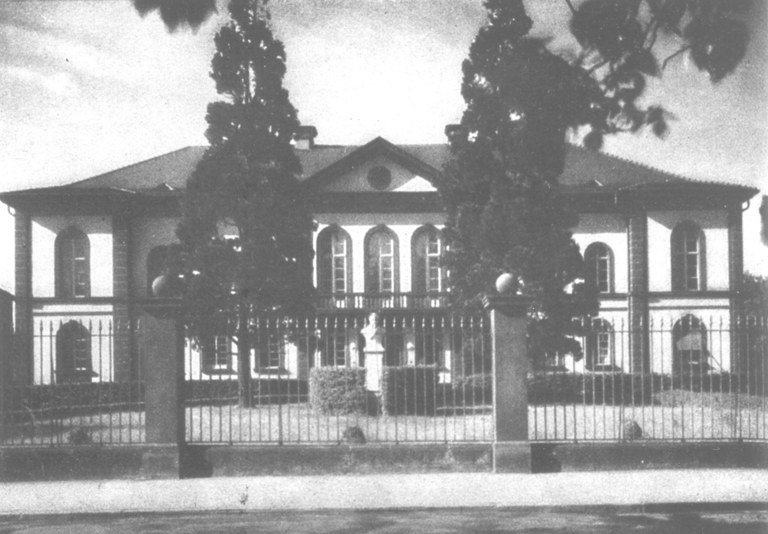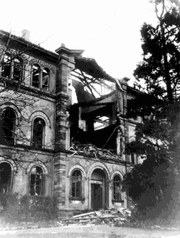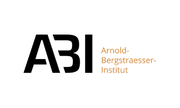The Alexander Ecker Collection
The collection was founded in 1857 by Alexander Ecker, an anatomist and anthropologist from Freiburg. It is composed of human skulls, bones, and casts that were acquired through donations, exchanges, and purchases. Since 2001, the Alexander Ecker Collection has been under the care of the University Archive and the Uniseum.
The designations are mostly historical and most of them do not correspond to the correct designations. The structure of the collection is oriented towards the continents.
The Alexander Ecker Collection - University Archive (Inventory M1)

Institute of Anatomy, 1900
History
XIX Century
- 1857: The collection was established by Alexander Ecker, an anatomist and anthropologist from Freiburg. For this purpose, he drew on several specimens from the 18th century, which originated from cemeteries, were brought to Freiburg by colleagues and students, or were purchased from dealers.
- 1862: The collection of Theodor Bilharz was added to Ecker's collection.
- 1864: Crania of archaeological origin from so-called "row grave fields” were added to the collection.
- 1867: A public display of the collection was established in the new institute building.
- 1872: The collection of Heinrich Schreiber, which mainly originated from excavations in the Upper Rhine region, was added to the Alexander Ecker collection.
- 1878: A catalog of the collection was published.
- From the 1880s on: The collection fell into a "twilight state" until Eugen Fischer showed increasing interest in it (influenced by racial ideology). Apparently, he also reorganized and re-signed the collection.

View into the Anatomy collection, 1900
XX Century
- Around 1907: Eugen Fischer wrote the last entries in the handwritten inventory. After Fischer's departure to the Kaiser Wilhelm Institute in Berlin, another period of passivity followed for the collection.
- April 1917: An air raid destroyed the central wing of the institute, its collection rooms, and numerous objects, greatly damaging the collection. This is documented mainly photographically but is only partially reflected in the inventory. The gaps in the collection were subsequently filled in, but the documentation of these losses and additions has not been preserved.
- 1935: The private Gabriel-von-Max anthropological collection, which counted with more than 500 objects and which had been in the Städtisches Reiß-Museum Mannheim since 1917, was added to the Freiburg collection by order of the government of Baden. However, the annexation was incomplete: records, objects, documents concerning the collection, and some skulls remained in Mannheim.
- November 1944: The written records of the Institute of Anatomy were almost completely destroyed.
- After 1945: The Freiburg collection was relocated and the institute was rebuilt.
- 1950s: The collection was reorganized. In the process, the archaeological objects of human origin from prehistory and early history were added. However, the anatomists who were at the time formally in charge of the collection devoted little interest to it.
- 1985: The collection was once again inventoried by hand by student assistants.

Destruction of the Institute of Anatomy and the collection, 1917
XXI Century
- 2001: The University Archive and the Uniseum took over the collection. The loss of about 200 objects was discovered, which must have occurred between 1986 and 2001. In the course of processing the collection and through intensive contacts, several dozen objects were recovered and assigned to the missing parts.
- Summer of 2009: Two skulls were anonymously returned.
When the collection was taken over by the University Archive and the Uniseum, numerous items were found to be missing. These are marked as "missing 2001", the year the collection was taken over. Some of the items missing at that time have been recovered. These are marked as "recovered”.
Fundamental problems with the identification of the specimens
 There is a large documentation gap in the inventories between the years 1907 and 1985. On April 14, 1917, during World War I, the collection suffered major war damages and losses due to an air raid and a subsequent fire that destroyed large portions of it. During its reconstruction in the following years, destroyed and lost specimens were replaced by equivalent or similar specimens. However, it is not documented which specimens were lost or replaced.
There is a large documentation gap in the inventories between the years 1907 and 1985. On April 14, 1917, during World War I, the collection suffered major war damages and losses due to an air raid and a subsequent fire that destroyed large portions of it. During its reconstruction in the following years, destroyed and lost specimens were replaced by equivalent or similar specimens. However, it is not documented which specimens were lost or replaced.
The written records of the Institute of Anatomy were almost completely destroyed by World War II on November 27, 1944. Therefore, the documentation has very large gaps and the inventory can no longer be traced without doubt for the period between 1907 and 1986. To put the identification of the specimens on a secure basis, an anthropological cross-check of the specimens is absolutely necessary. Only biological anthropology can verify or falsify whether or not the existing specimens and their provenance can be those of the historical description.
Source: Universitätsarchiv


